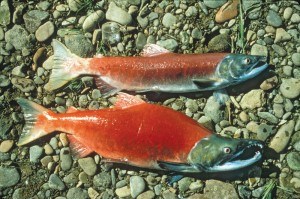
Valemount naturalist Bruce Wilkinson was out of town mid-September when he got the call. For the first time in 20 years, sockeye salmon had been spotted in Swift Creek near the Valemount Visitor Centre. The next day, Wilkinson got in his car and drove home to confirm the news.
Wilkinson observed six sockeye at Swift Creek, their fire-red bodies undulating in the current where only two to three weeks prior the Chinook salmon had finished spawning. He sent photos to Lester Jantz, the area director for Fisheries and Oceans Canada. Jantz confirmed the sightings, and would later suggest there were as many as 10 sockeye sighted in Swift and Camp Creeks.
This is by no means a lot of salmon compared to the thousands of Chinook that return each year. However, Jantz says the streams around Valemount are not typically sockeye habitat, as juvenile fish don’t have access to the freshwater lakes that are a vital part of their lifecycle. “There are some populations of sockeye that don’t require [access to] lakes, but generally those are found lower down in the Fraser River.”
So what were these sockeye doing in Swift Creek?
“They may be strays from another system,” says Jantz.
Jantz explains that “straying” happens when a small percentage of salmon in a population do not return to the tributaries where they were hatched, but instead make their way into new ones. “Most salmon species have individuals that do this.
“After the last glaciation, there were no salmon in many parts of British Columbia,” says Jantz. Straying is an important adaptation that salmon use to colonize new areas over a relatively short time frame. This behaviour has allowed salmon populations to colonize most of their current habitat in British Columbia.
The urge for salmon to return to their spawning grounds is called homing. It’s a strong impulse; a behaviour based on seasonal cues that help segregate salmon populations in time and place. Cues may include the “smell” of specific streams and rivers, and the position of the sun. Although there are many salmon populations that spawn along the Fraser River, the cues that signal their homing instinct are different.
Straying tends to occur early in the salmon migration, often within roughly 30 kilometres of the point at which they enter the system. Sockeye have typically shown low straying rates compared with other species like Coho. This might be one of the reasons why it’s been 20 years since their last sighting in the Valemount area.
Jantz says Fisheries and Oceans Canada does not have a program to count sockeye in the Valemount area, as sockeye have only occurred infrequently and in low numbers. To monitor the Chinook run, the department works with the Lheidli T’enneh First Nation, who concur that sockeye are infrequently observed.
Still, if salmon straying has resulted in the colonization of other areas of BC, is it possible that these stray sockeye are setting up shop for future generations?
Jantz says, “if you start to see them on a regular basis, then it’s possible they are establishing a viable population.” However, it’s more likely we’ll be waiting another 20 years.
Niki Wilson
Special to the 51����
